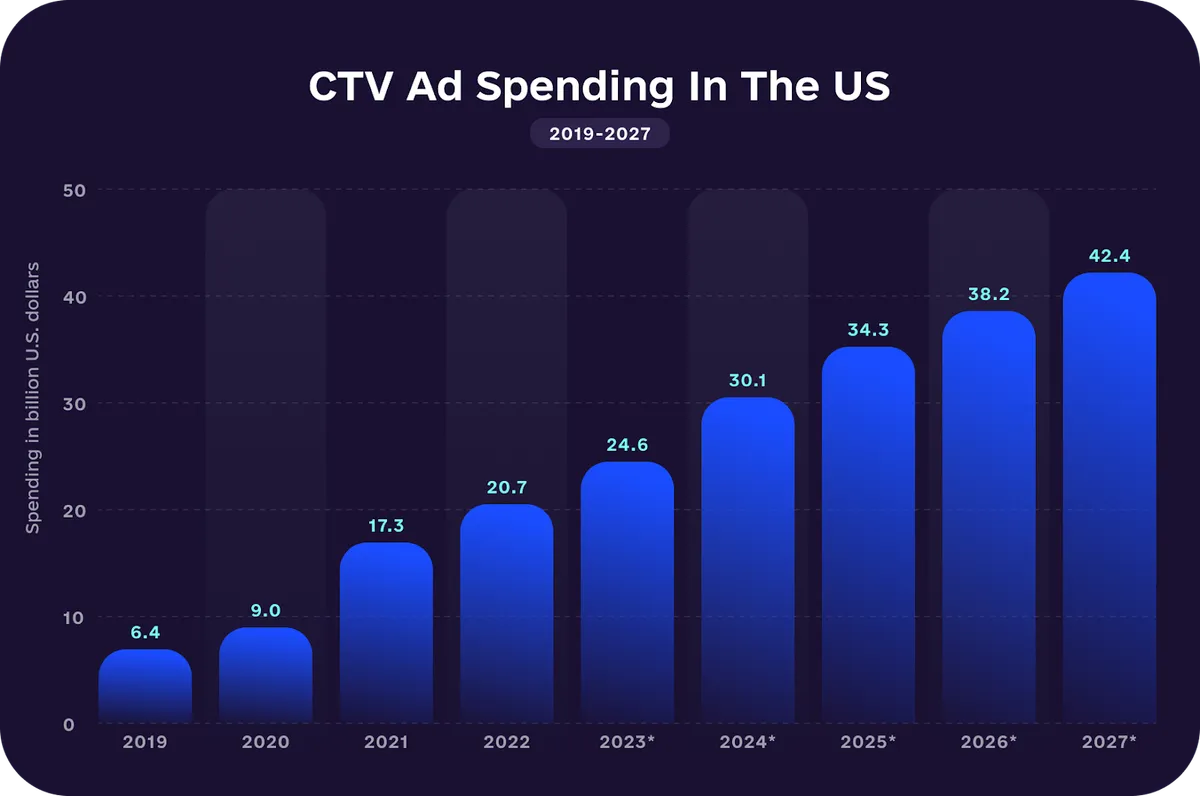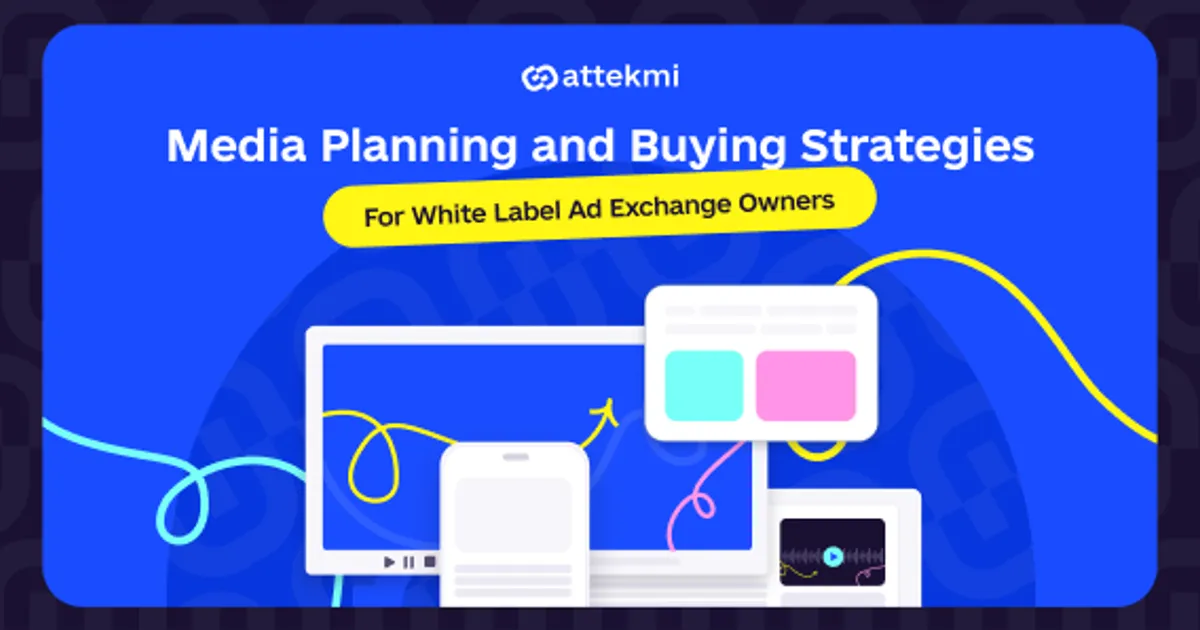Media buying and planning are two key components of the digital advertising landscape, and they are often confused with each other. However, our detailed guide is here to help. Discover the difference between media planning and buying, understand all the challenges, and find out what ad exchange owners should consider, and not only.
Key Takeaways
Media planning defines the campaign strategy – audience, channels, budget – while media buying executes that strategy by securing ad inventory through programmatic or other deals.
White label ad exchange owners must focus on five core priorities: advanced targeting, brand safety, fraud prevention, performance analytics, and strategic partner selection.
Automation, including features like adaptive margin and traffic filtering, helps streamline operations, increase profitability, and reduce manual work for exchange owners.
Emerging trends such as CTV and audio advertising, omnichannel targeting, real-time optimization, and privacy compliance are critical for staying competitive in media trading.
Attekmi provides ready-to-launch ad exchange platforms with robust integrations, analytics, and fraud prevention, helping partners like Streamkey and Phonder rapidly scale and boost revenue.
What is media planning and buying?
First and foremost, let's clearly define digital media planning and buying to prevent the potential misunderstanding from happening.
What is media planning?
Media planning is the basis of any advertising campaign. The media planning process involves thorough research (both internal and external), budget planning, audience identification and segmentation, and channel selection. Here is a brief media plan example for you:
The goals of the campaign are clearly defined.
The channels are prioritized, and the budget is allocated properly.
The KPIs are identified for effective campaign analysis.
The audience targeting and other characteristics are outlined.
The format and size of ad creatives are decided on, and the assets themselves are prepared.
What is media buying?
Now, let’s explore digital media buying. This process follows media planning and implies bringing the plan to life. Media buyers purchase ad inventory in multiple ways, including programmatic advertising, negotiating with suppliers, and so on. Their main responsibility is to understand where the ad space is and how to get it, along with creating contacts. To sum up, an advertising campaign should start with the planning activities, and then the ad space should be purchased. First comes media planning, then buying.
Challenges in advertising media planning and buying
For advertisers, media planning and placement are related to multiple challenges. It is essential for them to understand the market and its trends, conduct research, etc. Media planning platforms can help streamline this process. However, ad exchange owners also have some tasks to deal with. Instead of planning and launching advertising campaigns, they have the following challenges to solve. For example, one key challenge ad exchange owners face is handling VAST error codes.
Key challenges
So, here are some things you need to pay attention to.
Optimization
For any ad exchange owner, the essential task is to help advertisers implement their media planning strategy effectively, which involves matching supply and demand partners. Targeting settings may include numerous options, such as traffic type, ad format, ad size, price limit, and others. The more settings you can apply, the better for all the parties involved. While marketers will be able to reach their audiences, publishers will monetize their inventory effectively. As a result, your media trading income will grow.
Brand safety
For advertisers, brand safety plays a crucial role as they do not want their ads to be displayed next to inappropriate or simply irrelevant content. Therefore, your ad exchange platform should allow for creating white- and blacklists. Again, the more settings it is possible to apply, the better.
Ad fraud prevention
Both advertisers and publishers strive to avoid ad fraud, so your platform should meet their needs and be able to detect fake clicks and malicious creatives. There are numerous scanners available, and integrating them is a way to solve this issue.
Performance measurement
While advertisers need to measure the performance of their campaigns, and publishers need to understand how profitable their inventory is at the moment, you have to measure your media trading effort. A thorough analysis will reflect the efficiency of media buying via your platform, so the solution should be able to provide insights into supply and demand partners’ spend, total impressions, profit, etc.
Proven solutions from the Attekmi team
Developing an ad exchange platform from scratch and equipping it with all the essential functionalities is always time-consuming and expensive. Fortunately, choosing a solution from Attekmi is a way to speed up the process and start earning on media trading within a week. Take a look at some of its features:
Attekmi solutions offer a great selection of integration options for both DSPs and SSPs: OpenRTB 2.6, JS tags, header bidding, VAST to RTB, VAST to VAST, VAST to All, and DSP connectors for specific integrations. Along with advanced targeting settings, these features allow you to match demand and supply partners effectively, which ensures stable income.
Traffic filtering and management functionalities ensure maximum platform performance. You can apply numerous tools and features, including adult traffic filtering, price filtering, blocked categories, IPv6 traffic filtering, etc.
The platform is equipped with multiple traffic and demand scanners so that you can keep your media trading ecosystem safe. The available integrations include Pixalate, Protected Media, Forensiq, MediaTrust, etc. Feel free to learn more here.
An extensive analytics dashboard allows for data-driven optimization. You can identify the most profitable supply and demand partners, track total profit, and many more.
The supported traffic type options are desktop, in-app, mobile web, and CTV. As for the available ad formats, they are banner, video, audio, native, CTV, pop, and push ads.
The platform is compliant with data processing standards and privacy regulations, including GDPR, COPPA, CCPA, and TCF 2.0. It is also possible to generate ads.txt and sellers.json files to enhance transparency and prevent fraud.
To sum up, you can get an effective and fully customized solution without investing loads of time and money in development from scratch.
5 media planning & buying strategies for WL ad exchange owners
According to the challenges outlined above, the most effective strategies for white label ad exchange owners are as follows.
Come up with your own media marketing plan
As an ad exchange owner, the key thing you have to do is to identify reputable demand and supply partners with whom to cooperate. You do not need to prepare a traditional detailed media buying plan and decide what marketing channels to use. Instead, you should identify SSP and DSP platforms that you will work with. Doing this on your own can be challenging, but cooperating with a white label provider will help you achieve maximum results. Prefer a platform that has its own network of supply and demand partners. This way, you will start earning quickly.
Apply targeting settings
Marketers need to analyze their customers to enhance targeting and deliver their ads to the right users at the right time. In turn, you have to apply targeting to match supply and demand platforms effectively. The more settings you leverage, the more efficient performance your platform will show. Advertisers will reach their customers, publishers will complement user experience, and you will gain profit. Therefore, you need to get a full understanding of your partners and pay attention to the targeting and traffic filtering settings when choosing a white label solution.
Automate when possible
Effective media trading involves numerous aspects, and connecting demand and supply partners is only the tip of the iceberg. You should also integrate fraud scanners, decide on the margin, etc. Therefore, to optimize the processes, you need to leverage automation whenever it is possible. For instance, certain white label solutions offer automatic margin calculation, which is a way to automate some routine tasks and optimize your platform’s performance. When selecting a platform, choose the one with automation features and learn how to use them. This way, you will optimize your media trading processes and get an opportunity to focus on more important tasks. Additionally, it would be wise to prefer a solution that is regularly updated with new functionalities.
Eliminate ad fraud
White label programmatic ad exchanges are usually equipped with fraud detection mechanisms, and you should not neglect them. Select the solution that offers a variety of traffic and demand scanners and find out how to integrate them in the right way. Besides, to ensure a safe environment for your partners, choose a platform that is already compliant with standards like GDPR and CCPA. By doing so, you will also make your platform look more credible, which will help you attract supply and demand connections.
Analyze continuously
For all the participants of the digital advertising ecosystem, continuous analysis plays a crucial role. You, as an ad exchange owner, are not an exception. Choose a white label platform that offers advanced analytics capabilities to analyze the performance of your solution and enhance your strategy according to these insights.
Future trends and innovations in media buying and planning
Media planning and buying are evolving continuously, offering new trends that advertisers, publishers, and owners of ad exchanges should keep in mind. To drive media trading income, you must be able to adopt new initiatives quickly. Therefore, when choosing a white label platform, make sure to prefer one that is upgraded on a regular basis and allows you to meet the current demand and supply needs. Meanwhile, here are several innovations and tendencies to consider.
CTV advertising
CTV ad spend is growing. In 2019, it reached $6.4 billion (in the US), but the rate is expected to exceed $42 billion by 2027. Considering this, ad exchange owners have to offer CTV among their traffic channels. Otherwise, it can be challenging for them to remain competitive.

Audio advertising
Audio advertising is also on the rise — ad spend here is projected to surpass $40 billion worldwide in 2024. This is not surprising since the number of voice assistants is increasing. While advertisers and publishers should plan their activities with audio opportunities in mind, ad exchange owners need to have such functionality on their platforms.
Programmatic advertising
It is also possible to expect the growing popularity of programmatic advertising. Due to its convenience and automation capabilities, more and more marketers and publishers switch to this model to increase efficiency and ROI. For those who manage ad exchanges, this is an obvious benefit. However, to maintain competitiveness, it is essential to keep an eye on the rivals and continuously analyze their platforms to detect new opportunities.
AR and VR
Augmented and virtual reality are other trends to consider. Offering highly immersive experiences, they help advertisers drive attention and convert customers. In digital advertising, VR and AR are still in the early stages, but the first adopters will definitely stand out from the crowd. This applies to all the parties involved: marketers, website and app owners, and ad exchange providers.
An omni-channel approach
An omni-channel model is not something new to advertising, but this trend is not expected to fade away. To reach their audiences, marketers need to utilize an entire set of channels, including social networks, DSPs, traditional media, and so on, and deliver consistent messaging. For ad exchange owners, this implies the need to match demand and supply partners correctly.
Real-time optimization
To ensure the effectiveness of an advertising campaign, marketers need to track its performance in real time and make relevant adjustments. Again, this is not a new tactic, but since the competition in the market is getting more and more severe, we can expect it to play a crucial role in the near future. Owners of ad exchanges also should monitor the performance of their platforms to react on time.
Focus on privacy
The third-party cookies are still here, but the process of their complete elimination is inevitable. Besides, modern users are highly concerned about their privacy, so it is crucial for marketers to start adapting their strategies and relying on first-party data and contextual targeting. As for ad exchange owners, they need to keep their solutions compliant with all the relevant standards.
Platform partnerships
One more thing that we can expect in terms of media buying and planning is the growing number of partnerships between different platforms to enhance user experience. For example, Meta recently introduced a new feature for US Amazon customers. Thus, users can link their Instagram and Facebook accounts to Amazon and purchase advertised products without the need to leave the platform. Since customer experience is the main focus now, we can forecast even more similar partnerships to enter the stage and enhance digital media buying.
Learn more about Attekmi expertise
As you already know, choosing Attekmi solutions is a way to join the AdTech ecosystem fast and start earning on media trading within a week – they are equipped with multiple features essential for ad exchange owners in terms of media plan strategy. However, now let’s review the results you can achieve with Attekmi:
With the adaptive margin feature (a functionality that automatically calculates the most optimal margin), Streamkey managed to double its profit in 2 months. Besides, they upscaled their platform from 10k to 20k QPS in only one month.
Phonder grown its revenue by 87.47% and upscaled to 200K QPS in 1 year.
Choosing Attekmi means that you do not have to be an expert in media planning in advertising. Our support team is always here for you, ready to solve any of your challenges and help you maximize media trading income.
Does Attekmi look like the right solution? Then let’s get in touch!
FAQ
What is the difference between media planning and media buying?
Media planning involves thorough research and analysis to identify the most effective channels, segment the audience, and so on. In turn, media buying refers to purchasing ad inventory programmatically or in any other way. Basically, for an advertising campaign, media planning is the first step, followed by media buying.
What is a media plan?
A media plan is a document outlining all the key information for an advertising campaign: the objectives of the campaign and its KPIs, communication channels, budget, and target audience characteristics. It performs as a basis for the media buying plan, ensuring that the goals will be reached effectively.
Why is media planning crucial for white label ad exchange owners?
For ad exchange owners, media planning is not the same as for advertisers, but it still plays a key role. They need to have a deep understanding of their supply and demand partners to establish the right connections and drive income.
 By Iryna Kozirevych
By Iryna Kozirevych